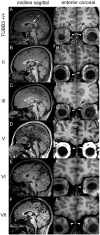A novel syndrome caused by the E410K amino acid substitution in the neuronal β-tubulin isotype 3
- PMID: 23378218
- PMCID: PMC3572929
- DOI: 10.1093/brain/aws345
A novel syndrome caused by the E410K amino acid substitution in the neuronal β-tubulin isotype 3
Abstract
Missense mutations in TUBB3, the gene that encodes the neuronal-specific protein β-tubulin isotype 3, can cause isolated or syndromic congenital fibrosis of the extraocular muscles, a form of complex congenital strabismus characterized by cranial nerve misguidance. One of the eight TUBB3 mutations reported to cause congenital fibrosis of the extraocular muscles, c.1228G>A results in a TUBB3 E410K amino acid substitution that directly alters a kinesin motor protein binding site. We report the detailed phenotypes of eight unrelated individuals who harbour this de novo mutation, and thus define the 'TUBB3 E410K syndrome'. Individuals harbouring this mutation were previously reported to have congenital fibrosis of the extraocular muscles, facial weakness, developmental delay and possible peripheral neuropathy. We now confirm by electrophysiology that a progressive sensorimotor polyneuropathy does indeed segregate with the mutation, and expand the TUBB3 E410K phenotype to include Kallmann syndrome (hypogonadotropic hypogonadism and anosmia), stereotyped midface hypoplasia, intellectual disabilities and, in some cases, vocal cord paralysis, tracheomalacia and cyclic vomiting. Neuroimaging reveals a thin corpus callosum and anterior commissure, and hypoplastic to absent olfactory sulci, olfactory bulbs and oculomotor and facial nerves, which support underlying abnormalities in axon guidance and maintenance. Thus, the E410K substitution defines a new genetic aetiology for Moebius syndrome, Kallmann syndrome and cyclic vomiting. Moreover, the c.1228G>A mutation was absent in DNA from ∼600 individuals who had either Kallmann syndrome or isolated or syndromic ocular and/or facial dysmotility disorders, but who did not have the combined features of the TUBB3 E410K syndrome, highlighting the specificity of this phenotype-genotype correlation. The definition of the TUBB3 E410K syndrome will allow clinicians to identify affected individuals and predict the mutation based on clinical features alone.
Figures





Comment in
-
Complication begets clarification in classification.Brain. 2013 Feb;136(Pt 2):368-73. doi: 10.1093/brain/awt001. Brain. 2013. PMID: 23413256 Free PMC article. No abstract available.
Similar articles
-
Expanding the phenotypic spectrum and variability of endocrine abnormalities associated with TUBB3 E410K syndrome.J Clin Endocrinol Metab. 2015 Mar;100(3):E473-7. doi: 10.1210/jc.2014-4107. Epub 2015 Jan 5. J Clin Endocrinol Metab. 2015. PMID: 25559402 Free PMC article.
-
TUBB3 Arg262His causes a recognizable syndrome including CFEOM3, facial palsy, joint contractures, and early-onset peripheral neuropathy.Hum Genet. 2021 Dec;140(12):1709-1731. doi: 10.1007/s00439-021-02379-9. Epub 2021 Oct 15. Hum Genet. 2021. PMID: 34652576 Free PMC article.
-
TUBB3 E410K syndrome with osteoporosis and cough syncope in a patient previously diagnosed with atypical Moebius syndrome.Brain Dev. 2018 Mar;40(3):233-237. doi: 10.1016/j.braindev.2017.12.006. Epub 2017 Dec 27. Brain Dev. 2018. PMID: 29289389
-
TUBB3 M323V Syndrome Presents with Infantile Nystagmus.Genes (Basel). 2021 Apr 15;12(4):575. doi: 10.3390/genes12040575. Genes (Basel). 2021. PMID: 33921132 Free PMC article. Review.
-
[Congenital fibrosis of extraocular muscles (CFEOM) and other phenotypes of congenital cranial dysinnervation syndromes (CCDD)].Nervenarzt. 2005 Apr;76(4):395-402. doi: 10.1007/s00115-004-1742-3. Nervenarzt. 2005. PMID: 15221064 Review. German.
Cited by
-
Axonal Growth Abnormalities Underlying Ocular Cranial Nerve Disorders.Annu Rev Vis Sci. 2021 Sep 15;7:827-850. doi: 10.1146/annurev-vision-093019-114307. Epub 2021 Jun 3. Annu Rev Vis Sci. 2021. PMID: 34081534 Free PMC article. Review.
-
Genetics of hypogonadotropic hypogonadism.Transl Androl Urol. 2021 Mar;10(3):1401-1409. doi: 10.21037/tau.2020.03.33. Transl Androl Urol. 2021. PMID: 33850776 Free PMC article. Review.
-
Molecular genetic diagnostics of hypogonadotropic hypogonadism: from panel design towards result interpretation in clinical practice.Hum Genet. 2021 Jan;140(1):113-134. doi: 10.1007/s00439-020-02148-0. Epub 2020 Mar 28. Hum Genet. 2021. PMID: 32222824 Free PMC article. Review.
-
A Mutation in the Tubulin-Encoding TUBB3 Gene Causes Complex Cortical Malformations and Unilateral Hypohidrosis.Child Neurol Open. 2016 Sep 1;3:2329048X16665758. doi: 10.1177/2329048X16665758. eCollection 2016 Jan-Dec. Child Neurol Open. 2016. PMID: 28503613 Free PMC article.
-
An exome sequencing study of Moebius syndrome including atypical cases reveals an individual with CFEOM3A and a TUBB3 mutation.Cold Spring Harb Mol Case Stud. 2017 Mar;3(2):a000984. doi: 10.1101/mcs.a000984. Cold Spring Harb Mol Case Stud. 2017. PMID: 28299356 Free PMC article.
References
-
- Abid F, Hall R, Hudgson P, Weiser R. Moebius syndrome, peripheral neuropathy and hypogonadotrophic hypogonadism. J Neurol Sci. 1978;35:309–15. - PubMed
Publication types
MeSH terms
Substances
Supplementary concepts
Grants and funding
LinkOut - more resources
Full Text Sources
Other Literature Sources
Medical
Molecular Biology Databases

